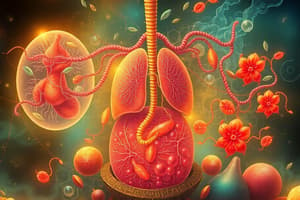Podcast
Questions and Answers
What is the main product of aerobic respiration besides ATP?
What is the main product of aerobic respiration besides ATP?
- Glucose
- Alcohol
- Carbon dioxide (correct)
- Lactic acid
Which type of organism primarily uses anaerobic respiration?
Which type of organism primarily uses anaerobic respiration?
- Photosynthetic organisms
- Obligate anaerobes (correct)
- Facultative anaerobes
- Aerobic organisms
What characteristic is true about facultative anaerobes?
What characteristic is true about facultative anaerobes?
- They only perform fermentation.
- They can switch between aerobic and anaerobic respiration. (correct)
- They produce lactic acid exclusively.
- They exclusively need oxygen for survival.
What is the approximate net gain of ATP molecules from anaerobic respiration?
What is the approximate net gain of ATP molecules from anaerobic respiration?
What happens to pyruvate in the absence of oxygen during anaerobic respiration?
What happens to pyruvate in the absence of oxygen during anaerobic respiration?
Why do muscles feel sore after intense exercise?
Why do muscles feel sore after intense exercise?
What metabolic pathway can occur when mitochondria runs out of glucose?
What metabolic pathway can occur when mitochondria runs out of glucose?
What effect does exercise have on the efficiency of oxygen delivery in the body?
What effect does exercise have on the efficiency of oxygen delivery in the body?
Flashcards are hidden until you start studying
Study Notes
Cellular Respiration Overview
- Two primary types: aerobic and anaerobic respiration.
Aerobic Respiration
- Requires oxygen to fully extract energy from carbohydrates, proteins, or lipids.
- Yields 36 to 38 ATP molecules per glucose molecule.
- Produces carbon dioxide as a byproduct, which is expelled during breathing.
- Enhanced exercise increases the efficiency of oxygen delivery and carbon dioxide removal.
Anaerobic Respiration
- Takes place in the absence of oxygen.
- Some organisms, like specific bacteria and yeast, rely exclusively on this process.
- Results in the production of either 2 lactic acid molecules (in animals) or alcohol (in yeast/bacteria) per glucose molecule.
- Alcohol is utilized in various products such as beer, wine, liquor, cheese, and yogurt.
- Lactic acid accumulation in muscles leads to soreness after intense exercise.
- Also known as fermentation, used in the production of bread, sausages, yogurt, and buttermilk.
- Produces only 2 ATP molecules per glucose, making it less energy-efficient (approximately 2% efficiency).
- All individuals develop lactic acid in muscles post-exercise, with clearance rate indicating fitness level.
Obligate Anaerobes
- Organisms that exclusively perform fermentation or anaerobic respiration and cannot tolerate oxygen.
- Examples include specific yeast and many bacteria.
Facultative Anaerobes
- Capable of switching between fermentation and aerobic respiration based on oxygen availability.
- Pyruvate serves as a branching metabolic point, leading to alternative pathways for energy production.
Carbohydrate Metabolism
- Fully relies on oxygen, breaking down 2 pyruvate molecules into 6 carbon dioxide molecules and producing 36 ATP.
- In cases of glucose deficiency, the TCA cycle can utilize amino acids and triglycerides for ATP production, explaining the effectiveness of low-carbohydrate diets.
- Ketone bodies are generated when fats are metabolized, contributing to the state of ketosis as excess ketones may appear in urine.
- Carbohydrate metabolism facilitates rapid energy release, with glucose typically consumed within 30 to 60 minutes post-meal.
Studying That Suits You
Use AI to generate personalized quizzes and flashcards to suit your learning preferences.



